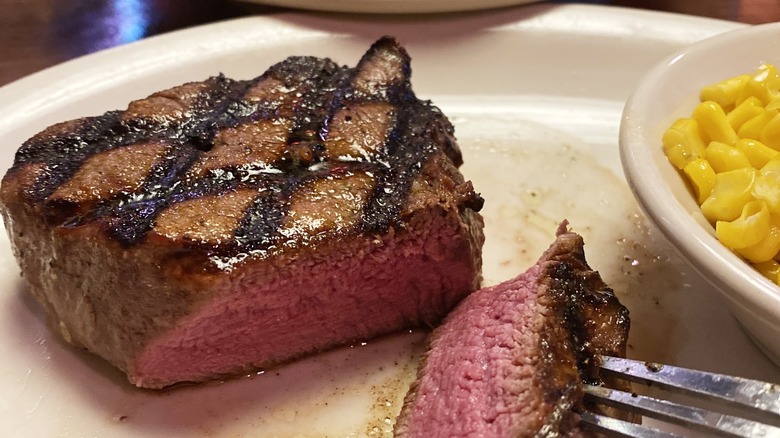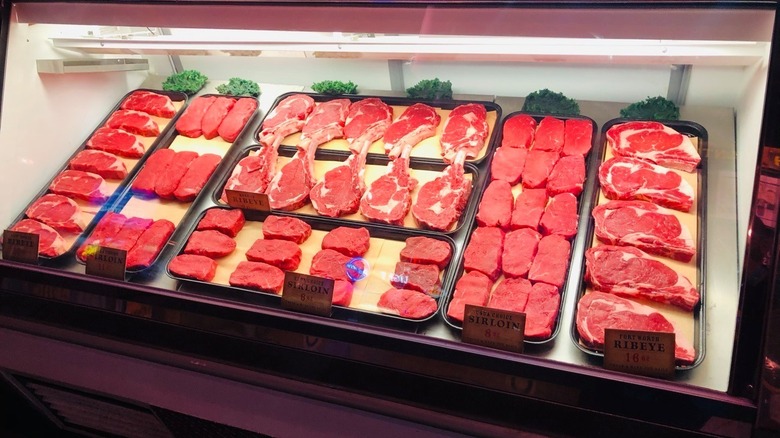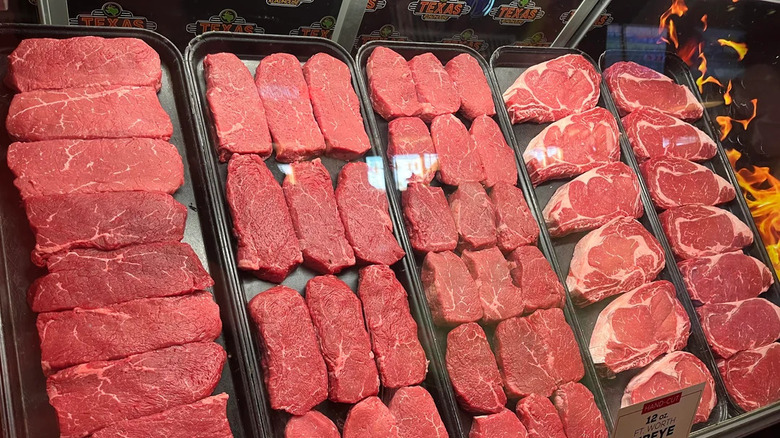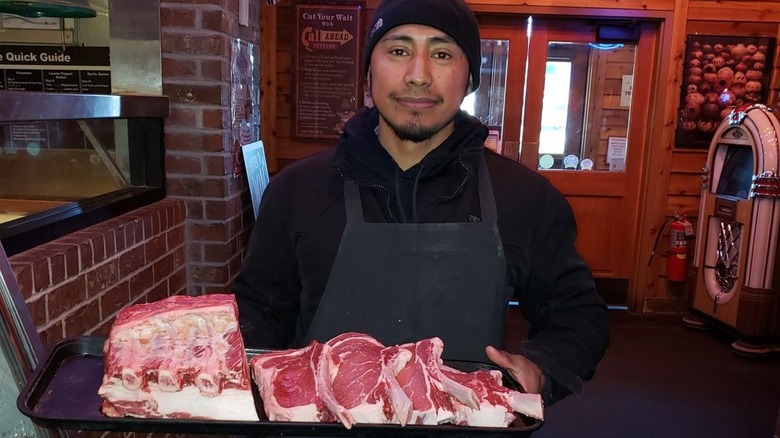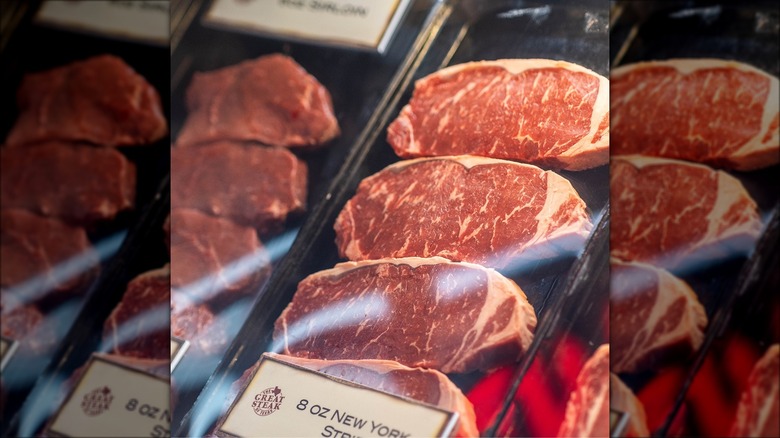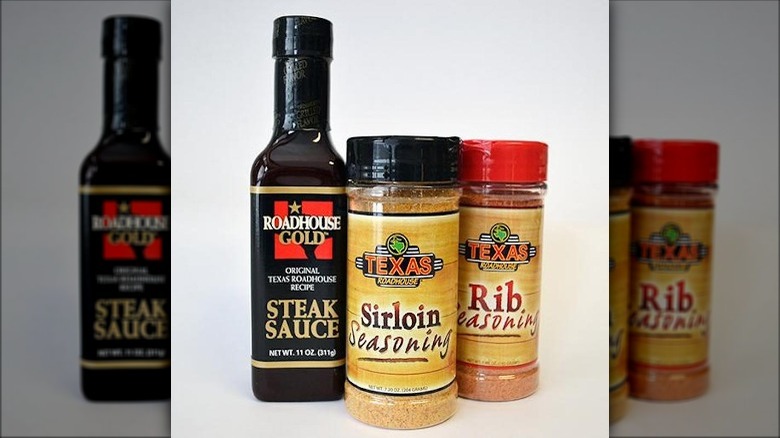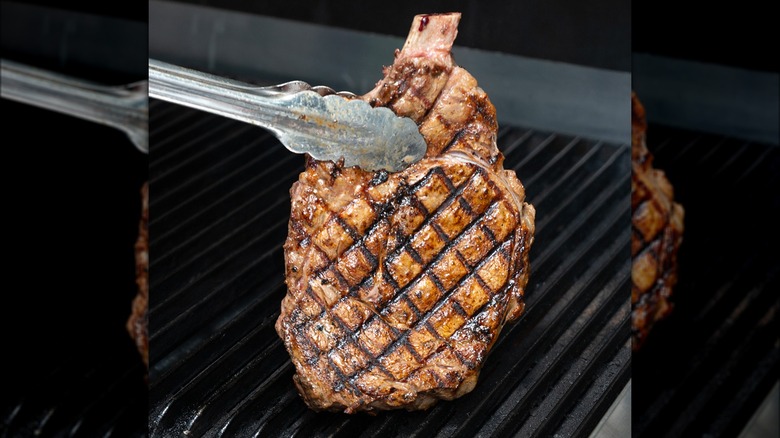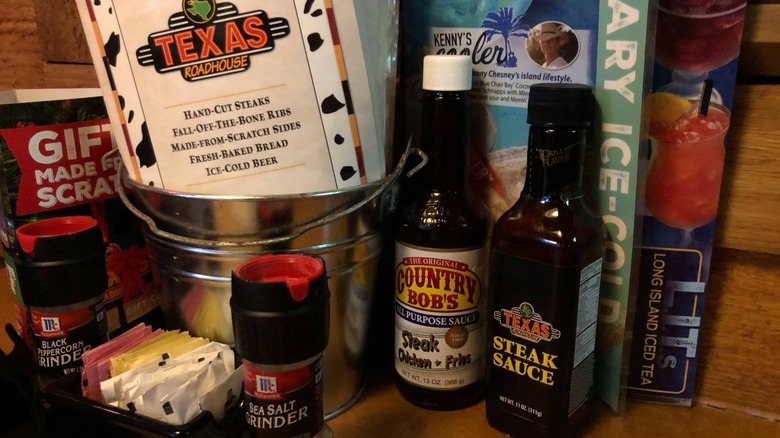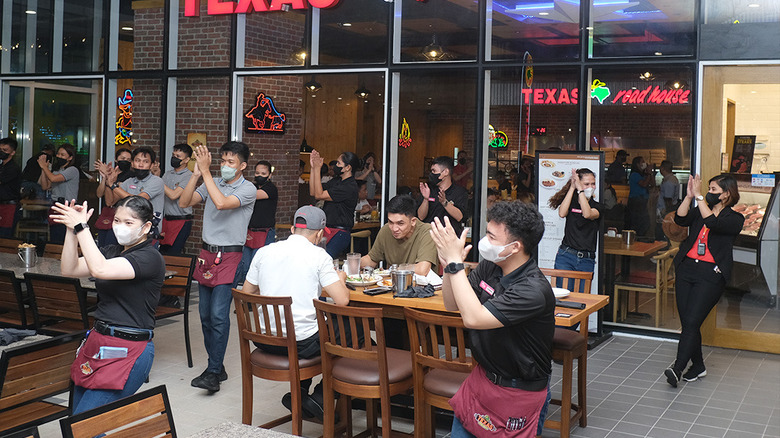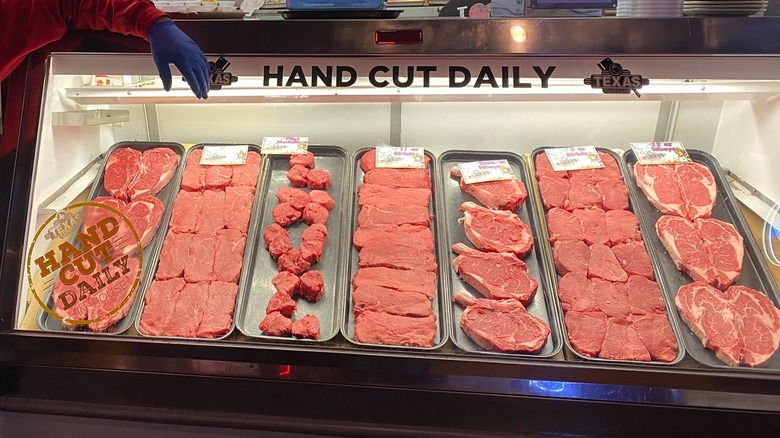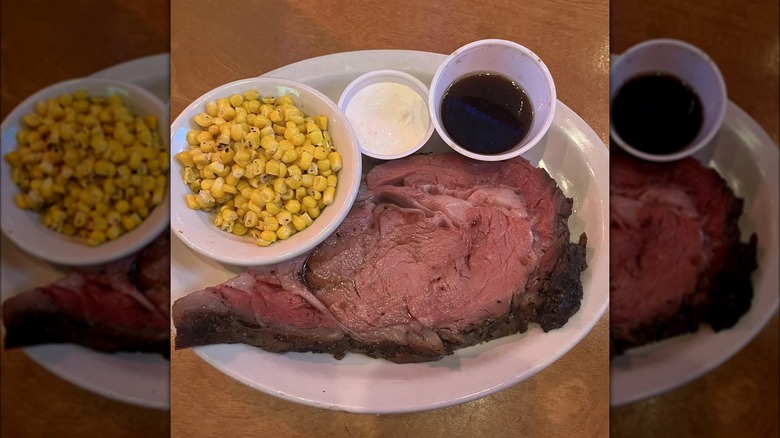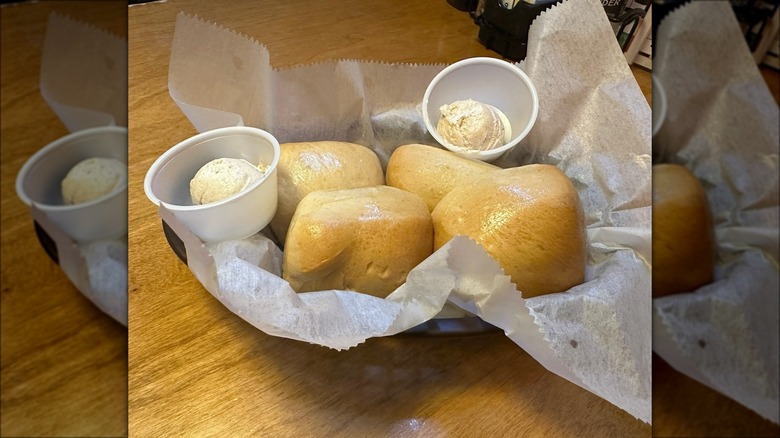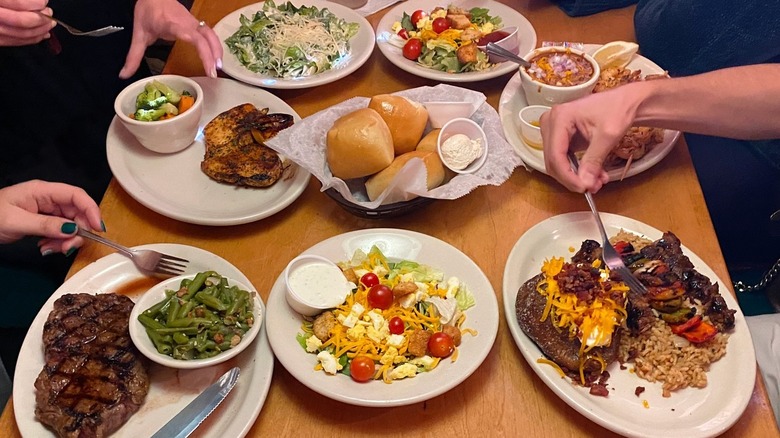What Makes Texas Roadhouse Steaks So Good?
We may receive a commission on purchases made from links.
When you think of Texas Roadhouse, the first things that come to mind are surely tossing peanut shells to the floor, servers performing corny line dances, and endless baskets of warm buns with that irresistible honey-cinnamon butter. However, the chain restaurant is celebrated by carnivores for serving up something else that makes our mouths water: succulent steaks.
Despite the name, Texas Roadhouse began in Indiana, specializing in southwestern and Texan cuisine. From humble roots, the restaurant blossomed into the largest steakhouse chain in the U.S., operating over 600 nationwide locations and even some international spots. The iconic Western-style roadhouse stays true to its reputation, boasting 10 hand-cut juicy steaks, making up 44% of its menu. While some Texas Roadhouse steaks are better than others, the chain has garnered fame for cooking up flavorful, tender steak, surpassing its competitors and even taking home first place in a few competitions. So what's the secret? Let's uncover the techniques that can take beef from mediocre to mouthwatering and discover what Texas Roadhouse does to make a great steak.
Texas Roadhouse serves high-quality beef
Texas Roadhouse's steak prowess starts with quality beef. While you can mask an average or low-quality cut of meat with heavy seasoning, you cannot mimic the juiciness and flavor of high-grade beef. According to its FAQ page, Texas Roadhouse selects USDA-certified beef that has been grain-finished for 120 days. While that may sound like a lot of marketing jargon, these terms can signify an enhanced steak flavor and texture.
Grain-finished means the cattle freely roamed pastures for most of their lives and were fattened up with hay, grains, and corn just before slaughter. This results in meat that is buttery, flavorful, and almost sweet, allowing it to be fork-tender when cooked properly.
USDA-certified indicates the steaks adhere to a strict grading system that determines the meat's quality. The scale starts with Prime, followed by Choice and Select. The rankings reflect the amount of marbling in the cut –– an indispensable factor in keeping the meat moist as it cooks. USDA Prime beef boasts the highest amount of marbling for the juiciest final product, while Choice has slightly fewer streaks of fat, and Select is the leanest, lacking the same rich flavors and marbling as the other grades. Texas Roadhouse typically serves Choice cuts, ensuring a good balance of fine meat and fatty tenderness.
Texas Roadhouse uses fresh, never-frozen beef
Texas Roadhouse sources its superior-quality beef from various locations around the world, including Australia, Canada, and the U.S. Midwest. Meanwhile, the steakhouse chain promises to use fresh, never-frozen meat.
Fresh and never-frozen paints a homey, farm-to-table feel, but they also indicate that you'll receive a more tender and tastier steak on your plate. That's because fresh meat boasts a higher nutrient count and can better show off its original, unadulterated flavor. While freezing beef can be convenient and extend its expiry date, Texas Roadhouse makes the extra effort to guarantee your steak is as fresh as possible and doesn't lose any robust flavor in freezer stays. When frozen, moisture within the muscle crystalizes and can damage the cut's inherent qualities and textures. The real trick to preserving and respecting meat's flavor is freezing the cut quickly and hermetically, then defrosting it slowly and carefully.
So, while cooking with frozen meat doesn't necessarily equate to an inferior taste, the process must be done properly. By cooking fresh, Texas Roadhouse ensures a juicier cut brimming with its natural nutrients, eliminating any risk of flavor loss in the freezing or thawing process.
In-house professional butchers hand-cut every steak
Let's face it: cooking the perfect steak at home can be daunting. Most carnivores prefer beef charred on the outside and juicy within, but several factors influence the desired result. From marbling, muscle fibers, and quality to the proper cooking techniques and tools, steak is one of those dishes many of us prefer to leave to the professionals. Relying on butchers to properly cut the beef is a safe bet for avoiding exhaustive chewing and achieving buttery goodness.
Before landing on your plate, every steak at Texas Roadhouse meets the skilled hands of a meat cutter. These professionals are fluent in beef and trained to juggle all the factors to hand-cut the perfect slab of meat, leaving only the best bits for the customer. According to Texas Roadhouse's fact sheet, its experts butcher steaks daily in a cooler to preserve the meat's goodness, amounting to millions of dollars of steaks yearly per location. Hand-cutting steaks also allows the meat to be left whole upon delivery, retaining all its moisture and guaranteeing greater consistency and even cooking in every cut.
Instead of cutting steaks by machine, the meticulous hands of a butcher cause less friction and greater precision when removing excess fat or muscle fibers that can leave steaks rubbery. As one Texas Roadhouse meat cutter explained to Market Screener, "We have a cut-across-the-grain technique to maintain just the right marbling so the restaurant can serve the tastiest, most succulent steaks."
Steaks at Texas Roadhouse undergo an in-house aging process
Once the beef arrives at Texas Roadhouse, meat cutters guide it through an in-house aging process. Although there are plenty of techniques for perfecting tender steak, aging the cuts in a controlled and salty environment helps break down tough muscle fibers, resulting in a richer, more succulent, final product. The aging process can be wet or dry, where dry aging means leaving the steak in an open-air space free of contaminants, and wet aging means leaving the cut in a vacuum-sealed package with its natural juices.
Even if America's biggest steak chain hasn't confirmed whether it employs wet or dry aging, Tasting Table guesses it could be wet-aging thanks to the steak's melt-in-your-mouth, buttery nature. Because wet-aged steaks retain practically all of their natural moisture, fans of the method swear the meat is juicier and sweeter, with a more nuanced meaty flavor.
To many, dry-aged steaks are like a punch of umami to the face and only require a bit of salt and pepper, whereas wet-aged steaks are said to pair better with seasonings and sauces. In any case, two Texas Roadhouse employees shared in a cooking segment on WBRC that the restaurant's steaks are aged for ample time, from about two weeks for tenderloins and up to 25 days for all other cuts. This allows the meat plenty of time to reach its peak tenderness and flavor profile.
Texas Roadhouse uses a unique, secret steak seasoning
Seasoning is another key component to Texas Roadhouse's perfect, savory steaks. The restaurant's blend of spices, herbs, and salt doesn't drown the meat's natural goodness but highlights and complements its robust flavors.
An alleged former employee revealed on Reddit that cooks slather both sides of each steak in a healthy dose of the proprietary seasoning before searing them and cementing the flavors. While the magic powder is another reason Texas Roadhouse's steaks make your mouth water, you might be out of luck if you're looking to take some home. Although the company tweeted about its Sirloin Seasoning in 2015 with a link to buy the product, the purchasing page has since been taken down and nothing appears to have taken its place.
With the specific recipe seeming to be under lock and key, plenty of Internet sleuths have taken a stab at deciphering the ingredients, attributing it to the success of the chain's great steaks. A Texas Roadhouse Sirloin Seasoning (along with its list of ingredients) is listed on Amazon, disclosing a blend of sugar, garlic, and onion (though it is also currently unavailable). The list continues with paprika, turmeric, and an umbrella term of spices. Commenters on another Reddit thread guessed that one of these mysterious spices could be chili powder. In any case, Texas Roadhouse's steak seasoning nails sweet, salty, and spicy in every bite.
Chefs expertly prepare the steaks to order
When you order a steak at Texas Roadhouse, rest assured the meat is cooked fresh to order. The chefs' expertise and a proven cooking method are another reason the chain's steaks are so delectable.
According to a purported former Texas Roadhouse cook writing on Quora, the chain's steak cooking method begins at a flattop grill surrounded by two gas grills. The flattops are cranked up to a sizzling 500 degrees Fahrenheit and coated in soybean oil –– widely considered to be a great cooking oil for meats thanks to its neutral flavor. Chefs slather the steaks in Texas Roadhouse's proprietary seasoning before searing each side on the flattop for one minute, locking in moisture and creating a flavor bomb of a crust.
After two minutes of searing, chefs transfer the steaks to the gas grills where each side receives its attractive diamond pattern and it all cooks until reaching your requested doneness. Although it's almost finished at this point, your steak undergoes one last step to achieve perfection: resting. Letting the meat rest before serving is essential because the steak will continue cooking even after being taken off the grill. Here, chefs allow steaks to rest for about two minutes, letting carryover cooking nail the desired temperature. The meat's juices also rise during cooking, meaning if you cut into it immediately, all that savory goodness could spill onto the plate. Resting lets the muscle fibers relax, evenly redistributing the juices.
Texas Roadhouse's sauces pair perfectly with the steaks
Texas Roadhouse's stupendous meat speaks for itself, but the restaurant's sauces help take it to the next level. Whether you love a steak smothered in a creamy concoction or you're more of a purist who prefers a drop of steak sauce per bite, the restaurant offers a variety of housemade mixes that masterfully complement and uplift the meat.
For example, the chain's tender filet medallions are typically topped with a peppercorn or portobello mushroom sauce, creating a magnificent textural collision between buttery meat and peppery, earthy gooeyness. A Texas Roadhouse chef divulged in a cooking segment on WTAP that the sauce's flavor comes from portobellos and condensed mushroom soup, cooked down and combined with pepper, garlic, and sugar.
Filet medallions are currently the only steak option topped with sauce, but if you love to dip, each table also has a bottle of Texas Roadhouse's steak sauce. The proprietary sauce blends classic smoky flavors with somewhat more unique ingredients like raisin paste and tamarind extract. If that sounds strange, imagine the sweetness from raisins teaming up with the subtle sourness of tamarind to highlight the steak's meatiness, and you'll understand. From sweet and sour to smoky and salty, Texas Roadhouse's steak sauce ignites all our taste buds, reminding us how good its steaks are.
Texas Roadhouse's atmosphere and staff make you feel right at home
Part of what makes Texas Roadhouse's steaks great is that they are the stars of a show surrounded by incredible supporting actors. A Texas Roadhouse steak eaten out of its charming, albeit sometimes corny, context wouldn't taste the same. That includes the all-out Americana seen in many of the chain's restaurants, complete with wood paneling, longhorn cattle skulls, and flashy neon jukeboxes. One untold truth about Texas Roadhouse is that each location decorates the walls with local murals and memorabilia, giving your meal a homier feel. The cowboy theme sets the scene for a hearty meal with a personal touch.
Another uniquely Texas Roadhouse detail is the bucket of peanuts on every table. Restaurant-goers can snack on the bottomless peanuts, famously tossing the shells to the floor while waiting for their meals (though that detail may vary from franchise to franchise). The harkening to a bygone Wild West gives the experience an unserious, loosen-your-belt feel that lets you forget about appearances and focus on how good the food tastes.
Texas Roadhouse's staff, popularly known as "Roadies," also go the extra mile to make guests feel at home. Apart from the hourly server line dances that help frame your meal as a hoe-down spectacle, the waitstaff is also often applauded for their Southern-style hospitality and excellent service. Founder Kent Taylor even went so far as to originally source staff by visiting other restaurants and recruiting the most charming servers.
You choose steak at Texas Roadhouse from behind a counter
A humble butcher's window is one of the first things you'll likely notice when entering any Texas Roadhouse location. Inside the glass case, you can admire rows of raw, USDA Choice steaks — but it isn't just for display. The meat counter is also your chance to pick the cut you'd like to eat, as well as another symbol of the cowboy chain's steak prowess.
A journalist from the Daily Hampshire Gazette visited a Texas Roadhouse restaurant and likened the meat window experience to checking your luggage. You point out the steak you'd like, the butcher hands you a ticket to give to your server, and your chosen, sizzling, cut of meat will be placed in front of you.
Aside from giving your meal a personal touch, the meat counter proves that Texas Roadhouse upholds its promise of serving fresh steaks –– you can see exactly what you'll get right behind the window. The cuts of meat basking in the glass case could also indicate that the steaks are at room temperature before grilling –– an essential factor in quicker cooking times and juicier results.
You can also peruse the glass case to study the variety of steaks on the restaurant's menu. Behind the window, it's clear that part of what makes Texas Roadhouse's steaks so great is it's ability to cater to all carnivores' tastes and preferences, from the top-selling 6-ounce sirloin to bone-in ribeyes, New York strips, and T-bone steaks.
Texas Roadhouse's prime rib is slow-roasted to excellence
The trick for most of Texas Roadhouse's steaks is quickly searing and grilling the meat to create flavorful crusts and help lock in moisture. The chain does nearly the opposite with its prime rib, cooking it slow and low to achieve delicious, meaty tenderness.
On a WABI5 local news cooking segment, a Texas Roadhouse chef revealed the chain's proven prime rib process. His first tip was "to not be scared of the meat," generously massaging the slab of prime rib with spices and herbs. He included soy sauce, honey, and garlic to create an irresistible sweet and salty combo that boasts extra moisture. He also explained that the meat needs to be marinated for at least four hours.
After marinating, chefs slide the prime rib into a 300-degree oven and let it slow roast for around four hours. This gives the meat's tight collagen strands plenty of time to dissolve into fall-apart goodness. The chefs check the prime rib with a thermometer as the meat roasts, removing it when the steak is nearly medium-done, serving it crispy and brown around the edges but juicy and pink throughout. As with all buttery soft meats, the chefs' last step is to give the steak ane estimated 15 minutes of rest time, letting carryover cooking achieve that perfect final temperature and texture.
You can use one of Texas Roadhouse's steaks to build a mouthwatering slider
If you're not keen on forking and knifing your way through a 20-ounce steak, you can still savor Texas Roadhouse's succulent meat in a slightly different manner. We're all familiar with the warm and welcoming basket of rolls with honey-cinnamon butter on every table, right? Homemade and baked fresh every five minutes, many things make Texas Roadhouse's rolls delicious, but you may have been too enamored with them alone to realize you can also use them to build an irresistible steak slider.
Since it's not something you can order from the waiter, it's technically not a secret menu item –– so consider it a hack. Save a few buns and a bit of butter for when your steak arrives, or just order another basket because they're unlimited. Cut your steak into bite-sized pieces, open the buns, spread some butter, then stuff the meat inside. The buns are almost as soft as cinnamon rolls but paired with the juiciness and umami flavor from the steak, you've got a sweet and savory masterpiece.
The menu hack can be enjoyed with any steak on Texas Roadhouse's menu, but the filet medallions would be a great option because they're served in three small, tender filets. An impassioned TikTok user who had dined at the restaurant shared that these sliders are also a great option if you're on a budget. As he enthusiastically described, a single steak could feed a family of eight.
Texas Roadhouse steaks are affordable
Price is one thing that can really take you out of the moment while enjoying a meal. You're cutting into the steak and at the same time dreading how much it'll drain your account. Many would consider eating at a steakhouse or choosing the steak option to be a fine-dining luxury, and with beef prices steadily increasing, this is often the case.
The great thing about Texas Roadhouse is its steaks are often considered to be fine-dining quality with a chain restaurant price tag. The roadhouse has famously kept its steaks cheaper than competitors, helping you forget the cost and focus on how good they are. The 6-ounce sirloin will currently only set you back $15.49 (and that's with two sides included). According to FRED Economic Data, a pound of wholesale USDA Choice sirloin costs $14.08 per pound in February 2024. So, how can the restaurant keep prices so low?
Affordable steaks are foundational to the restaurant, so Texas Roadhouse has mastered a few techniques to keep things cheap without sacrificing quality. Each location employs an in-house butcher who expertly cuts meat with minimal waste, creating an eco-friendly and money-saving tactic. The Western-inspired chain also saves costs by hardly ever changing the menu, letting the chefs excel where they're best, and saving money on advertising changes. A steadier menu also allows the chain to set up long-term contracts with its beef suppliers, helping to protect prices against economic fluctuations and uncertainty.
